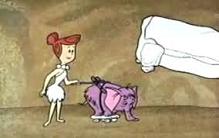

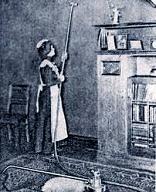

TLW's Vacuum Cleanerscope™ |
By T.L. Winslow (TLW), the Historyscoper™ |
© Copyright by T.L. Winslow. All Rights Reserved. |
Original Pub. Date: Apr. 14, 2015. Last Update: July 3, 2018. |
Alternate url for this page:
http://tinyurl.com/vacuumcleanerscope
What Is A Historyscope?
Infographic of Vacuum Cleaner History
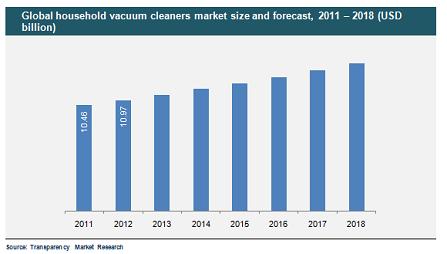
Westerners are not only known as history ignoramuses, but double dumbass history ignoramuses when it comes to Vacuum Cleaner history. Since I'm the one-and-only Historyscoper (tm), let me quickly bring you up to speed before you dive into my Master Historyscope.
Call it the Great War on Dirt. The vacuum cleaner is a key invention because it determines the level of cleanliness in the home and inevitably embodies all that modern technology can give it, call it the trickle-down theory, yet everybody thinks that they can invent a better one if they have enough time and a cool enough workshop.
It's surprising how long it took for the invention race to get going. The thieves stole everything in the house except the soap and towels, the dirty bastards. For centuries homes were cleaned with brooms, mops, carpet beaters and other simple devices, and only the rich who could hire servants could live in a home with more than a handful of rooms. It's only in the last 2.5 centuries that machines were harnessed for cleaning and marketed to the masses.

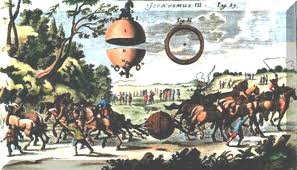
In 1650 German physicist Otto von Guericke (1602-86) of Magdeburg invents the vacuum air pump (now he's got both friction and suction?); in 1655 he uses it to remove the air from two metal Magdenburg hemispheres and challenges horsemen to pull them apart; it ends up being used on farms.
Vacuum cleaners started out as manual vacuum cleaners, look ma, no electricity. Read closely and see if you can learn in what year the electric ones were invented.
In 1811 James Hume of England patents the first floor-sweeping machine, consisting of a box containing a brush that is turned by a pulley.
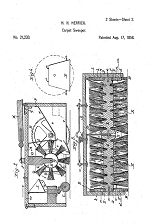
On June 11, 1858 Lucius A. Bigelow of England patents (1,327) an improvement on James Humes' sweeping machine; on Aug. 17 Hiram H. Herrick of East Boston, Mass. patents the first carpet sweeper (#21,233); on Sept. 21 and Nov. 23 Alfred Vincent Newton of England patents (2,122 and 2,660) more improvements; too bad, they're all hard to use and inefficient, and are commercial flops.
On Jan. 4, 1859 Augustus C. Carey of Lynn, Mass. receives U.S. Patent #22,488 for a "fan carpet sweeper" that uses a fan held close to the carpet in place of the usual revolving brush to save on carpet wear, blowing dust into a container.
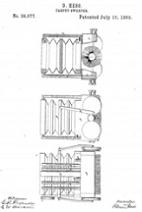
On July 10, 1860 David Hess of West Union, Iowa receives U.S. Patent #29,077 for an improved carpet sweeper using a bellows that sucks dust into two water chambers.
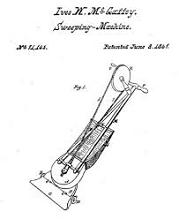
On June 8, 1869 Ives W. McGaffey of Chicago, Ill. patents the Whirlwind Sweeping Machine (#91,145); the operator has to turn a crank and push at the same time - proof that Chicago sucked before the Cubs?
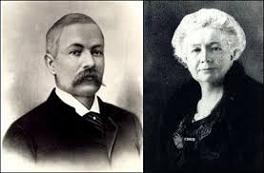

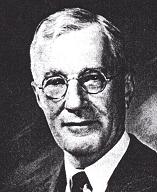
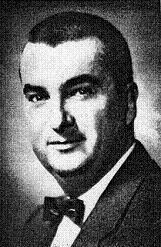

On Sept. 19, 1876 Am. china shop owner Melville Reuben Bissell (1843-89) of Grand Rapids, Mich. is granted U.S. Patent #182,346 for the Bissell Carpet Sweeper (called the Grand Rapids) to help his wife Anna Sutherland Bissell (1846-1934) get rid of the dusty straw her china comes packed in, after which she becomes a door-to-door salesperson, selling them for $1.50 each; their first manufacturing plant is built in Grand Rapids in 1883; when he dies she takes over the co., becoming the first U.S. female CEO, helping it go international and become #1 worldwide; in 1928 they introduce a sweeper that automatically adjusts the height of the brushes to fit the surface; in 1928 Melville Reuben Bissell Jr. (1882-) takes control of the co. from his mother; in 1953 his nephew (son of Irving J. Bissell) Melville Reuben Bissell III () takes over from him, expanding the company emphasis to floor care then complete home care.

In 1890 the Baby Daisy vacuum cleaner (designed in France) is introduced in Britain, with suction created by a canvas bellows operated by a footplate, with a metal hose and cotton bag for collecting dust; the bellows operator leans on a broomstick mounted on top; "This movement was a key design feature as it has a double connected bellows, meaning that movement in either direction created a vacuum"; the whole unit is dragged around on boards.
On Oct. 6, 1891 George L. Cummings of New York City receives U.S. Patent #460,935 for a "pneumatic sucker" hood that that rests on casters to reduce friction, a flexible hose, and a vacuuming apparatus that can be carried by a truck or permanently installed in a large bldg.
On Jan. 10, 1893 James J. Harvey of Kidminster, England receives British Patent #546 for a "pneumatic dusting machine" "for removing dust from the surface of books, ornaments, pictures, and the like", requiring two operators, "one of them working a bellows and the other pushing the dust collector from place to place".
In 1896 J.E. Howard and J.C. Tate receive British Patent #2,577 for an improved apparatus "to remove dust from cushions, carpets, and other articles", using compressed air to generate suction.
On Mar. 1, 1898 A.F. Gue and P.J. Bonner receive British Patent #5,050 for an improved carpet sweeper and beater with a rotary brush, beaters, rocker shaft with flat spring, rotary gear-wheel, fan to provide suction, and a water tank covered by a grating with a layer of curled hair.
On June 14, 1898 J. Eaton-Shore receives British Patent #13,298 for a device "for withdrawing and sterilizing dust and other minute or light particles of matter", consisting of a hooded broom with suction.
On Nov. 29, 1898 Franz Burger of Fort Wayne, Ind. receives U.S. Patent #614,832 for a "machine for cleaning fabrics", consisting of dual steam-powered "vacuum-chambers" (first known use of the term "vacuum" for a cleaning device), a boxlike rectangular "extractor" with a perforated face and rollers to be pressed to the fabric, and a flexible connecting tube with a rigid tubular handle with a hand valve to turn off the suction when not needed; the whole unit can be mounted on a stationary base in a bldg. or on a wheeled truck.
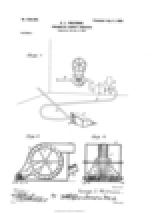
On July 11, 1899 George L. Westman receives U.S. Patent #628,505 for a "pneumatic carpet-sweeper", consisting of a hand-cranked exhaust fan, a hose, and a handle.
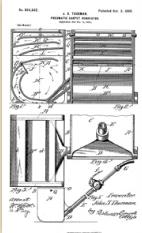
On Oct. 3, 1899 John Thurman of St. Louis, Mo. receives U.S. Patent #634,042 for the "pneumatic carpet renovator", a horse-drawn gasoline-powered vacuum cleaner, going door-to-door for $4 a visit; it uses compressed air instead of suction, becoming the first motorized vacuum cleaner; there are only 2.5K gasoline-powered automobiles in the U.S.
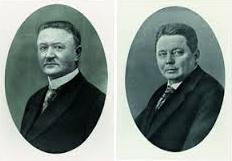
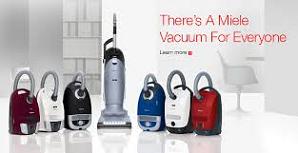
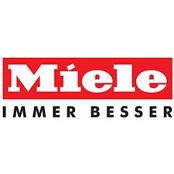
In 1899 the Miele co. is founded in Herzebrock, Germany by Carl Miele Sr. (1869-1938) and Reinhard Zinkann (1869-1939) to manufacture cream separators, butter churns, and washing machines, with a logo consisting of the name with a slashing i, and the slogan "Er is geen betere" (There is no better), going on to expand to automobiles in 1912, washing machines in 1914, bicycles and motrccles in 1924, vacuum cleaners in 1927, dishwashers in 1929, and dryers in 1958; in 2007 it beats Google as the most successful co. in Germany, with Porsche coming in 3rd.

The first decade of the 20th cent. sees vacuum cleaner technology take off, don't skip it. In 1900 60% of the U.S. pop. lives in rural areas sans electricity, which doesn't stop those who have it from wanting the newfangled devices, with 200+ manufacturers springing up by 1920.
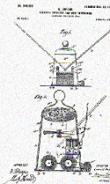
On Dec. 18, 1900 Corinne Dufour of the Savannah, Ga. patents (#664,135) the first "electric carpet sweeper and dust gatherer", which uses wet sponges and a suction fan.


On Feb. 18 and Aug. 30, 1901 after English inventor Hubert Cecil Booth (1871-1955) reverses the design of a railway car cleaner he saw demonstrated at St. Pancras Station in London, forming the British Vacuum Cleaner Co., he patents the first modern cylinder vacuum cleaner (the Puffing Billy) that sucks rather than blows, using a cloth filter and electrical pumps, first used in Feb. 1902; it is so huge it has to be drawn by a horse and stand in the road while cleaning houses, while the "noisy serpent" spooks passing horses, with employees wearing bright red uniforms, signing up shops and theaters; in 1902 he is given a royal warrant of appointment, causing society hostesses to hold parties to watch it at work; it is used to clean the carpets in Westminster Abbey before Edward VII's coronation, which "so impress the crowned heads of Europe that they all wanted a similar machine", after which it is adopted by the Royal Navy for use in barracks; the co. goes on to supply ever-larger models to factories and warehouses, changing its name to British Vacuum Co., attemping to market the Goblin model to homes but losing out to Hoover; it is later acquired by Quirepace Ltd.


In 1902 threatened by competition from the phonograph, music box manufacturer Regina Co. in Jersey City, N.J. (founded 1892) begins making 2-person hand-pumped pneumatic vacuum cleaners (patent #847,947, 1907) (patent #1,016,921, 1912), which sell poorly along with the music boxes, causing the company to go bankrupt in 1922, surviving the 1930s with canister vacuum machines, and introducing their stick model the Eletrik Broom in the 1940s; in 1997 it is acquired by Oreck Co.; in 2000 it is acquired by the Royal Corp., which sells vacuum cleaners under the Home Depot brand.

In 1903 David T. Kenney (1866-1922) of New York City receives his first patent for a vacuum cleaner, installing the first one in the Henry Clay Frick Bldg. in Pittsburgh, Penn. in 1902, with steam pipes reaching throughout the structure; in 1906 he claims to have installed electric vacuum cleaning systems in the White House and New York Times Bldg.; he goes on to receive eight more patents by 1913, dominating the vacuum cleaning industry until the 1920s after the Vacuum Cleaner Manufacturers' Assoc. is formed in 1919 by licensees of his patents, esp. the one covering the opening in the nozzle that seals contact with the carpet.
In 1905 P.A. Geier Co. is founded in a garage in Cleveland, Ohio by Philip Geier to market household appliances; in 1937 they introduce the Princess (Royal Prince), "the industry's first hand-held vac"; in WWII they make military parts; in 1953 they go bankrupt and are acquired by Walter E. Scott Org. (owner of the Cincinnati Reds ML baseball team) and renamed Royal Appliance Mfg Co., marketing the first household vacuum with a metal case and patented Cyclone system in 1955, selling 25M units; in the 1980s they begin selling Dirt Devil vacuum cleaners with plastic cases, and finally make it big with the Dirt Devil Hand-Held Vac in 1984, becoming #3 behind Hoover and Eureka until the 1990s.

In 1905 Walter Griffiths of Birmingham, England invents the first portable vacuum cleaner, with a flexible hose and interchangeable nozzles, worked by a single operator who has to compress a bellows to suck dust through the hose; some models have two bellows operated by treading on them alternately by one operator while the second operator works the hose and nozzle - the first Stairmaster?
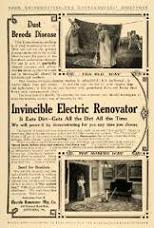
In 1905 Dr. William Noe of San Francisco, Calif. builds the first portable electric vacuum cleaner, weighing 92 lbs., with a large DC electric motor, a 2-stage 18-in.-diam. turbine fan, and a rigid metal dust container mounted on the handle, with a thick floor nozzle containing a rotary brush, complete with wheels, or mounted on a board; Alonzo E. Chapman and Benjamin J. Skinner of the Skinner Manufacturing Co. in San Francisco begin manufacturing and selling it door-too-door, also offering a cleaning service priced by the square yard; on Oct. 31 Chapman files a patent application for his "pneumatic sweeper and renovator"; too bad, the co. bldg. is destroyed in the Apr. 18, 1906 San Francisco Earthquake, and on Jan. 1, 1907 Skinner and Chapman found the Electric Renovator Manufacturing Co. in Pittsburgh, Penn. to produce the Invincible Electric Renovator, facing patent lawsuits for years, finally getting Chapman's patent #1,183,952 granted on May 23, 1916, and Skinner's patent #1,185,354 granted on May 30, 1916.


In 1905 Ira Hobart Spencer (1873-1928) founder of the Organ Power Co. (1892), maker of the Organblow multi-stage turbine blower for organs founds the Spencer Turbine Cleaner Co. in Hartford, Conn. to make the Turbine Vacuum Cleaner, a stationary installed vacuum cleaning system with lightweight hoses that operates on only 5 in. of water suction, with a trademarked "sugar scoop" housing profile.
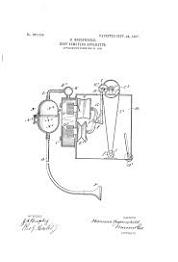
On Oct. 31, 1906 German immigrant Hermann Bogenschild of Milwaukee, Wisc. files a patent application (#341,468) for a dust-removing apparatus mounted on wheels with a hose connected to a filtering system.
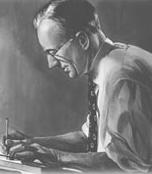
In 1906 Scottish-born inventor James B. "Jim" Kirby (1884-1971) of Richfield (near Cleveland), Ohio develops the first hand-powered vacuum cleaner (the Domestic Cyclone) that uses water to separate dirt and cloth to filter it out; next year he modifies it to use centrifugal action and cloth sans water; in 1919 Kirby partners with George Scott and Carl Fetzer, producing the Vacuette Electric in 1925, with removable nozzle and handle; in 1935 they introduce the Kirby Model C, the first vacuum cleaner with the Kirby name.
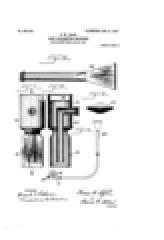
On Aug. 6, 1907 Frank W. Agan of Ludlow, Vt. receives U.S. Patent #862,369 for the Agan Vacuum, which requires one operator to turn a handle that runs the fan while the second operator operates the hose and nozzle, collecting the dirt and dust in a water tank.

In 1907 MIT-educated chemist and Home Economics founder Ellen Henrietta Swallow Richards (1842-1911) (first woman in the U.S. to earn a chemistry degree, and first woman admitted to MIT) pub. The Cost of Cleanness: Sanitation in Daily Life, which promotes the newfangled vacuum cleaners.

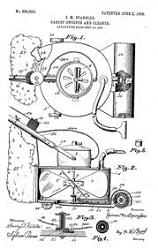
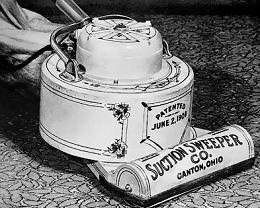

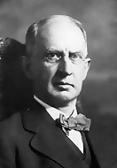
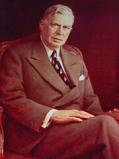
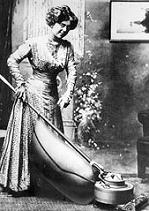
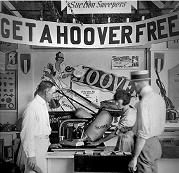

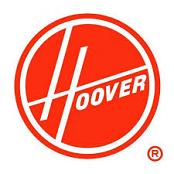
On June 2, 1908 asthmatic dept. store janitor James Murray Spangler (1848-1915) of Canton, Ohio patents the "electric suction sweeper" (#847,947), originally built out of an old fan motor mounted on a Bissell carpet sweeper, a soap box, broom handle, and pillow case, with refinements incl. a rotating brush to loosen debris; he goes around hawking them riding a bicycle; an early customer is his cousin Susan Troxel Hoover (1846-1925), whose leather goods manufacturer hubby William Henry "Boss" Hoover (1849-1932) of New Berlin (North Canton), Ohio goes on to purchase the patent from him in 1908 and found the Electric Suction Sweeper Co with $36K capital, serving as pres., with Spangler as production supervisor, which after his death becomes the Hoover Suction Sweeper Co., which in 1922 is renamed the Hoover Co., starting out offering a 10-day free home trial of its first model, the $125 ($60?) Model O (complete with steel casing, casters, and attachments), and er, sweeping the U.S. market, making "hoover" into a verb, adding a "beater bar" in 1919 (with the slogan "It beats as it sweeps as it cleans"), disposal filter bags in the 1920s, and an upright model in 1926; his son Herbert William Hoover Sr. (1877-1954), who helped all along takes over after the Boss dies.
On Nov. 7, 1908 Scientific American (99:320) pub. the article Home-Made Vacuum Cleaner, with instructions for a stationary system.
In 1909 Oliver S. Kendall (-1914) of Worcester, Mass., known for patent #459,901 (1891), the Dry Closet, a device for burning human waste begins marketing the pump-type Pneu-Simplex Vacuum Cleaner, in a wooden housing.
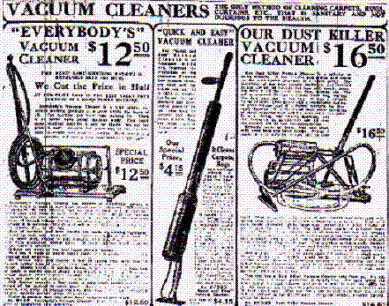
In fall 1909 Sears, Roebuck & Co. of Chicago, Ill. (founded in 1886) begins marketing manual vacuum cleaners, introducing three models by 1917, the 5 lb. Quick and Easy, the valve-and-piston pump type Dust Killer, and the bellows-type Everybody's Vacuum Cleaner, selling mainly to the rural market, where about 90% of 6.8M U.S. farms still don't have electricity by 1935, the year of passage of the U.S. Rural Electrification Act (REA); the number of these manual clunkers that actually found any use when a simple broom could often outperform them is in doubt; either way, the Great Dust Bowl began to form in 1934 in the U.S. and Canadian prairies, making vacuum cleaners useless until after WWII began.
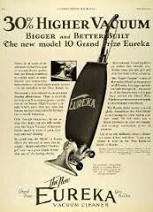
In 1909 the Eureka Vacuum Cleaner Co. is founded in Detroit, Mich. by Toronto, Canada-born real estate auctioneer Fred Wardell (1866-1952) to sell lightweight maneuverable vacuum cleaners for which he had acquired several patents, purchasing his first plant in 1913 and supplying six models via an east coast and a west coast distributor, reaching 2K units a day by 1919, hiring up to 3K door-to-door salesmen, reaching a one-third share by the mid-1920s and perennial #2 position in the vacuum cleaner industry behind Hoover, expanding into electric ranges and other appliances, then hitting a brick wall during the 1930s Depression, going into the red by 1937, and dropping door-too-door sales in 1940, seeing sales drop to 7% of the industry total before switching to war production in 1942; in 1945 looking to get into the postwar appliance boom it merges with oil burner and refrigerator manufacturer Williams Oil-O-Matic of Bloomington, Ill. (founded in 1918), becoming Eureka-Williams Corp.; in 1947 it introduces the Eureka Home Cleaning System, which combines a canister-type and upright vacuum for $144.95; in 1953 it is purchased by Henney Motor Co. of Freeport, Ill.; in 1959 it becomes a div. of Nat. Union Electric Corp., and in 1961 it becomes the first U.S. co. to manufacture a purpose-built electric car, the $3,500 Henney Kilowatt, which sells only 47 units; in June 1974 it is purchased by AB Electrolux of Sweden, becoming the Eureka Co. again, clinging to its #2 position in the market behind Hoover, with 20% of the $600M market in 1993 vs. 35% for Hoover, with 100+ models; in 2004 it changes its name to Electrolux Home Products Div.
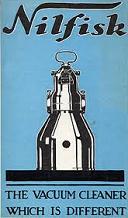
In 1910 the Fisker and Nielsen Co. in Denmark, founded by Peder Andersen Fisker (1875-1975) and Hans Marius Nielsen (1870-1954) becomes the first to sell vacuum cleaners in Europe; models weigh 17.5kg and can be operated by a single person; after Fisker patents it and buys out Nielsen, sales reach 1M by 1954; in 1994 it is renamed Nilfisk, and in 1998 it is renamed Nilfisk-Advance.

On Nov. 15, 1910 Herman G. Kotten of Englewood, N.J. receives U.S. Patent #975,435 for the Kotten Vacuum Cleaner, which requires the operator to stand on a platform and "rock from side to side like a teeter-totter, activating two bellows."
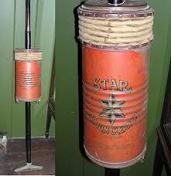
In 1910 the Star Vacuum Cleaner is patented in Britain (#18,899), consisting of a concertina-like drum that is pushed up and down the handle to suck dust through the cleaning head on top; too bad, it leaks a lot; the initial price is 54 shillings; it is discontinued in 1938.
In May 1910 Good Housekeeping mag. (50:665-6) reviews manual vacuum cleaners, asking "Do vacuum cleaners clean?", the answer being a qualified yes, warning that operating a pump vacuum requires two persons and is hard work; in 1912 the dir. of the Good Housekeeping Inst. observes that a "hand cleaner" weighing 15-25 lbs. with either pump or wheel is "not for a delicate woman" and not preferable to a carpet sweeper, although she did not test the lighter (5 lbs.) piston type; in 1917 the mag. again considers vacuum cleaners, electric models only; in 1921 the question originally posed in 1910 receives a yes answer after 554 readers return a questionnaire, all of them voting yes.
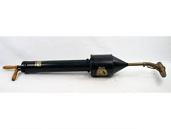
On Dec. 26, 1911 Charles Boyer of Marengo, Ill. receives U.S. Patent #1,012,800 for a plunger-type canister "vacuum-cleaning machine", which is manufactured by the Hugro Manufacturing Co. of Warsaw, Ind. under the name Golden Rod Vacuum Cleaner.
In Dec. 1911 the Water Power Vacuum Cleaner Co. in Buffalo, N.Y. is granted use of the trademark "WA-PO-VAC".
In 1912 Thomas' Register of American Manufacturers lists 50+ manufacturers of vacuum cleaners; in 1914 it lists 18 U.S. cos. offering hand-operated vacuum cleaners, vs eight in 1916; in 1914 it lists five U.S. cos. offering water-powered vacuum cleaners, vs. two in 1916.
In 1913 the Kenmore brand name is first used on sewing machines, expanding to washing machines in 1927, vacuum cleaners in 1932, ranges in 1946, dishwashers in 1951, washer-dryer combos in 1957, microwave ovens in 1971, and continuous-cleaning ceramic cooktop ranges in 1973.

In 1917-19 the U.S. is involved in WWI, which sucks a million fighting men into the trenches of Europe; for those left home, Hoover Co. offers a friction motor vacuum cleaner, which requires the operator to push it back and forth a few times to charge it up before lowering the intake to the floor and running the motor until it needs recharging.
In 1919 702K portable vacuum cleaners are sold in the U.S., most electric; in 1920 it rises to 1,024,167 units worth $35M.

In 1920 Air-Way Sanitizor of Toledo, Ohio begins marketing the first vacuum cleaner with a "filter fiber" disposable bag.
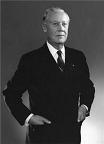
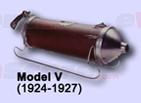
In 1921 Swedish designer Axel Lennart Wenner-Gren (1881-1961) designs the Electrolux Model V tank vacuum cleaner that lies on two removable thin metal runners and has a pistol grip on one end to push or pull it over the carpet, convincing his employer, the Swedish Electrolux lighting co. to buy his patent and pay him royalties in company stock; in 1924 Swedish-born businessman Gustaf Sahlin introduces it in the U.S., becoming an overnight success, raising the bar for competitors, after which they introduce the Model XI in 1927, the Model XII in 1930, the Model XXX in 1937, and many more thereafter; Wenner-Gren ends up owning the company by the early 1930s, becoming one of the wealthiest people in the world.
On Jan. 4, 1922 U.S. Senate Resolution No. 127 directs the U.S. Federal Trade Commission (FTC) to investigate the home furnishings industry; on Oct. 6, 1924 Vol. 3 is pub., covering vacuum cleaners, with Ch. 2 reporting that four cos. account for over half the industry's dollar volume, and that the rate of return on investment in the vacuum cleaner industry is 44.1%, "very much higher than the average rates of return... on house furnishings, domestic appliances" due to it being "a comparatively new device, the market for which is far from fully exploited and was protected by patents with limited competition."
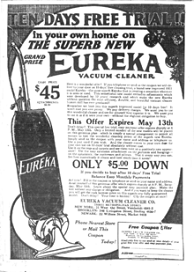
In 1922 Eureka ignores the 1926 expiration date of the original Hoover patents to introduce the $45 Eureka Model 9 upright vacuum cleaner, which is half the price of a Hoover and 6 lbs. lighter (11 lbs.) with the same motor horsepower, along with a front-mounted bag that won't hit furniture and spew dust unlike the rear-mounted bag on competitors' models, offering a 10-day free trial, becoming their best-selling model of all time, doing for vacuum cleaners what Henry Ford's Model T did for automobiles, selling 1M units in three years, vs. 713K for Hoover, and 2M units by 1927, reaching a one-third share, allowing them to expand into electric ranges and other appliances.
In 1923 the First Internat. Exhibition of Household Appliances AKA Salon des Arts Menagers (Ménagers) (Salon of Domestic Science) is held in Paris, reaching peak attendance in 1950, discontinued in 1983.
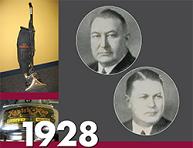

On Jan. 30, 1928 father-son team Martin and Frank Callahan along with Ray Owen found Sanitation Systems Inc. in Chicago, Ill. to direct-distribute for Scott & Fetzer of Cleveland, Ohio, approaching P.A. Geier Co. next year to build a high-end upright vacuum cleaner for them under the name of Health-Mor Sanitation System, changing their name in May 1930 to Health-Mor Sanitation Systems Inc.; in 1939 they acquire a 1928 patent from P.A. Geier Co. for a filterless cyclonic (wind tunnel) separation vacuum cleaner utilizing centrifugal force to generate suction and trap dust simultaneously, which they direct-market under the name Filter Queen 200, charging 20x the avg. price for the privilege of converting it into an air filter-freshener, paint sprayer, hair dyer, sander, and polisher; in 1968 they become HMI Industries, and go public in 1969, introducing the $2,500 Princess model in the early 1970s for the retail market, expanding globally in the 1990s and finding a good market in clean freak Japan; in Sept. 2004-Aug. 2006 they market the Majestic 360 floor cleaner; too bad, it can overheat and melt, creating a fire hazard, and on July 3, 2014 they agree to pay a $725K civil penalty to the U.S. Consumer Product Safety Commission.

In 1930 Hoover Co. introduces the Hoover Dustette, the first handheld vacuum cleaner.

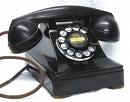
In 1930 Am. industrial designer Henry Dreyfuss (1904-72) wins a competition to design the sleek Western Electric 302 tabletop telephone for Bell Labs, going on to become a top industrial designer for Bell Labs, the Hoover Co., Westclox et al., co-founding the Society of Industrial Designers in 1944.
In the 1930s after introducing the first affordable refrigerator in the late 1920s, the Gen. Electric (GE) Co. enters the consumer appliance business, introducing washing machines, air conditioners, mixers, and vacuum cleaners; in 1932 it introduces the first electric dishwasher along with consumer financing of personal appliances.
In 1932 Hoover Co. introduces the Hoover Hedlite, an optional headlamp for Models 425, 750, and 900; in Mar. it becomes std. equipment on the 750 and 900, and a $5 option on the 425; "It shows you the dirt you never knew you had"; "It lights where it's going... it's clean where it's gone!"
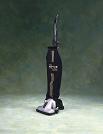

In 1936 Hoover Co. introduces the Hoover Junior, with the first sound modern design, becoming a big seller; it also introduces the Hoover Model 150 vacuum cleaner, designed by Henry Dreyfuss, featuring a non-coffee can magnesium body, 2-speed motor, instant tool conversion, and beautiful Bakelite hood with no protruding gadgets or knobs.
In 1941-5 (WWII) the U.S. vacuum cleaner industry converts to wartime production. In the early 1940s the HEPA (High Efficiency Particulate Arrestance) Filter is developed for the Manhattan Project to prevent the spread of airborne radioactive contaminants, and commercialized in the 1950s.
In 1946 after the war ends, a housing boom begins, with housing starts zooming from 200K in 1945 to 1.15M in 1950, with most new homes furnished with wall-to-wall (fitted) carpeting, and appliances incl. vacuum cleaners, causing vacuum cleaner sales to zoom from 1.3M units in 1940 to 3.5M units in 1950, with 21 manufacturers splitting the market.
In 1946 mechanic Nick Tacony begins selling sewing machines from his basement in St. Louis, Mo., going on to expand to vacuum cleaners et al. and incorporate the Tacony Corp., which builds a network of distribution centers; in 1984 his son Ken Tacony becomes CEO; in 1997 vacuum cleaner production is transferred from Taiwan to St. James, Mo., which goes on to produce 1M units.

In 1950 Eureka Co. introduces the Eureka 1950A RetroVac, the first convertible upright vacuum.
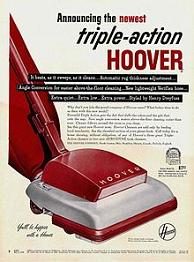
In 1950 Hoover Co. introduces the Hoover Model 29, with bright modern color schemes incl. red.
In the 1950s Craftool Co. founder Martin Miller invents the 5-gal. drum vacuum with water filtration for commercial shop environments, becoming the first vacuum cleaner to target a predominantly male market.

In 1954 Hoover Co. introduces the Hoover Constellation, the first vacuum cleaner that floats on a cushion of air like a hovercraft.
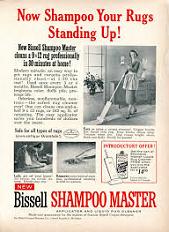
In 1957 Bissell Co. introduces the Bissell Shampoo Master, a nonelectric device that uses only water and detergent, discontinuing production in 1967 after slack demand; in 1960 they introduce the Bissell Stick Vac.
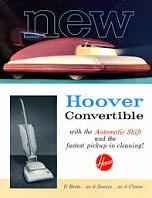
In 1957 Hoover Co. introduces the Hoover Model 65 convertible vacuum cleaner, designed by Henry Dreyfuss.
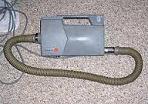
In 1960 only 5% of U.S. households own more than one vacuum cleaner; by 1966 it is 15%, as they buy one for deep cleaning and another for quick pickups; in 1964 GE introduces the MV-1 handheld vac, followed in 1966 by the SV-1 stick vac, selling 500K units by 1967.
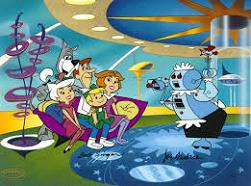
On Sept. 23, 1962 Hanna-Barbera Productions' The Jetsons animated series debuts on ABC-TV for 24 episodes (until Mar. 17, 1963), becoming its first color program; George and Jane, Judy and Elroy, Astro the dog, and Rosie the robot maid in Orbit City in 2062; 40-y.-o. George works a typical 2-day 2-hour workweek for boss Cosmo Spacely, owner of Spacely Space Sprockets, whose competitor is H.G. Cogswell of Cogswell's Cosmic Cogs; Rosie is the ultimate development of the vacuum cleaner?

In 1963 after acquiring a design from Whirlpool, Duluth, Minn.-born David Irving Oreck (1923-) begins selling lightweight vacuum cleaners by mail, finding a market in hotels.

In 1964 Metrovac (Metropolitan Vacuum Cleaner Co.) of Bronx., N.Y., founded in 1939 by Israel Gulker and his wife Pearl Stern with $50 capital, joined in 1957 by their son Jules Stern introduces the first 12V handheld car vac that plugs into the cigarette lighter outlet, which becomes a hit, allowing them to move to a 32K sq. ft. bldg. in Suffern, N.Y.; in 1970 they introduce the Metro Duo-Volt 110V-12V handheld vacuum cleaner that can be used in the home or car.
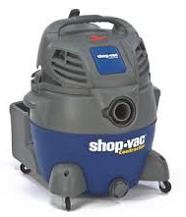
In 1967 the canister-style Shop-Vac wet/dry vacuum is introduced by the Shop-Vac Corp. of Williamsport, Penn.
On May 15, 1977 the first cordless vacuum cleaner is patented (#4,011,624) by Mark Anton Proett, who assigns it to Black and Decker.
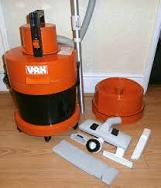
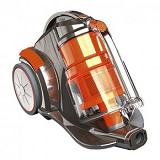
In Dec. 1977 Vax UK Ltd. is founded by Alan Brazier; in 1979 they introduce the 111/121 Orange Tub Multi-Functional Floor-Care Machine, which is not only suitable for normal household use but can wash carpets and handle spillages and flooding, selling it door-to-door until 1982, then stores, becoming the best-selling vacuum cleaner in the U.K. in 1987; in the 1990s they introduce the R2D2 wannabe Vax Mach Zen bagless multicyclonic cylinder vacuum cleaner with HEPA filtration, getting him sued in July 2010 by James Dyson, who loses; too bad, it's a dud, and drops off the market.
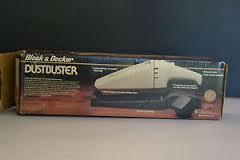
In Jan. 1979 Black and Decker introduces the DustBuster, the first cordless handheld vacuum cleaner, designed by Carroll Gantz and Mark Proett, becoming their best-selling gadget, selling 200M+ units.
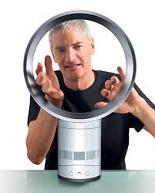
In 1983 British inventor Sir James Dyson (1947-) perfects the bagless "G-Force" vacuum cleaner after five years and 5K prototypes, using the principle of filterless cyclonic dirt separation; by 2013 he is worth £3B.
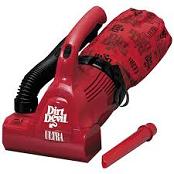
In 1984 Royal Manufacturing of Cleveland Ohio (founded 1905) introduces the Dirt Devil Hand Vac, which becomes a hit, selling 25M units; in 1996 the Ultra Hand Vac is introduced, with more suction; in 1996 the Broom Vac stick vacuum is introduced; in 2005 the Dirt Devil Classic Hand Vac is introduced, with 2x the power, a HEPA filter, and bagless dirt cup.
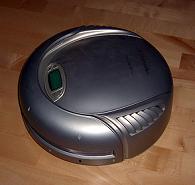
In 1997 Electrolux of Sweden demonstrates the Electrolux Trilobite, the first autonomous cordless robotic vacuum cleaner on the BBC-TV program "Tomorrow' World", introducing it to the consumer market in 2001 - imagine all the severed toes, ruined carpets, broken vases, mangled cat tails etc. during those years of development?
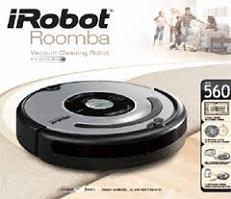
In 2002 the Roomba autonomous robotic vacuum cleaner, designed by Helen Greiner et al. is introduced by iRobot, selling 10M units by Feb. 2014.

In 2003 Mark Rosen (Rosenzweig), 3rd generation CEO of 100-y.-o. European-founded home appliance co. Euro-Pro Operating LLC moves the HQ from Montreal, Canada to Newton, Mass., revamping the product line with the cyclonic Shark Rocket, Shark Rotator, Shark Navigator, Shark Steam & Spray Mop, and Shark Vac-Then-Steam, causing vacuum cleaner sales to zoom from 1% of the market in 2008 to 20% ($1.6B) in 2014 after hiring advertising consultant co. Gap Internat. in 2012 and pushing the products on TV shopping channels with a $130M/year budget, passing Dyson and becoming #1 in the U.S. market.
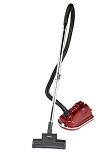
In 2004 British co. Airider introduces a lightweight hovering bagged canister vacuum cleaner.
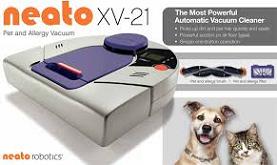
In Dec. 2009 Neato Robotics of Newark, Calif. introduces the $399 Neato XV Series, the first robotic vacuum cleaner with a rotating lidar range-finder and mapping software, featuring a 35 cfm impeller; in Mar. 2012 they introduce the Neato XV-21, designed for people with pets or allergies; in Mar. 2014 they release the BotVac, with a longer brush, filter area, and dust bin.
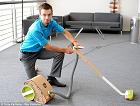
In 2011 British Loughborough U. student Jake Tyler (1989-) invents Vax ev, the first super-inexpensive vacuum cleaner made from cardboard.
In Sept. 2014 the EU passes new regulations for vacuum cleaners, limiting their energy use to 1.6KW, and 0.9KW in Sept. 2017.
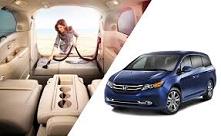
The 2014 Honda Odyssey minivan features the first built-in vacuum cleaner for a vehicle.

In 2015 Dyson releases its handheld Dyson V6 Mattress Cleaner, with a digital motor and HEPA filtration to get rid of dust mites.
Historyscoper Home Page